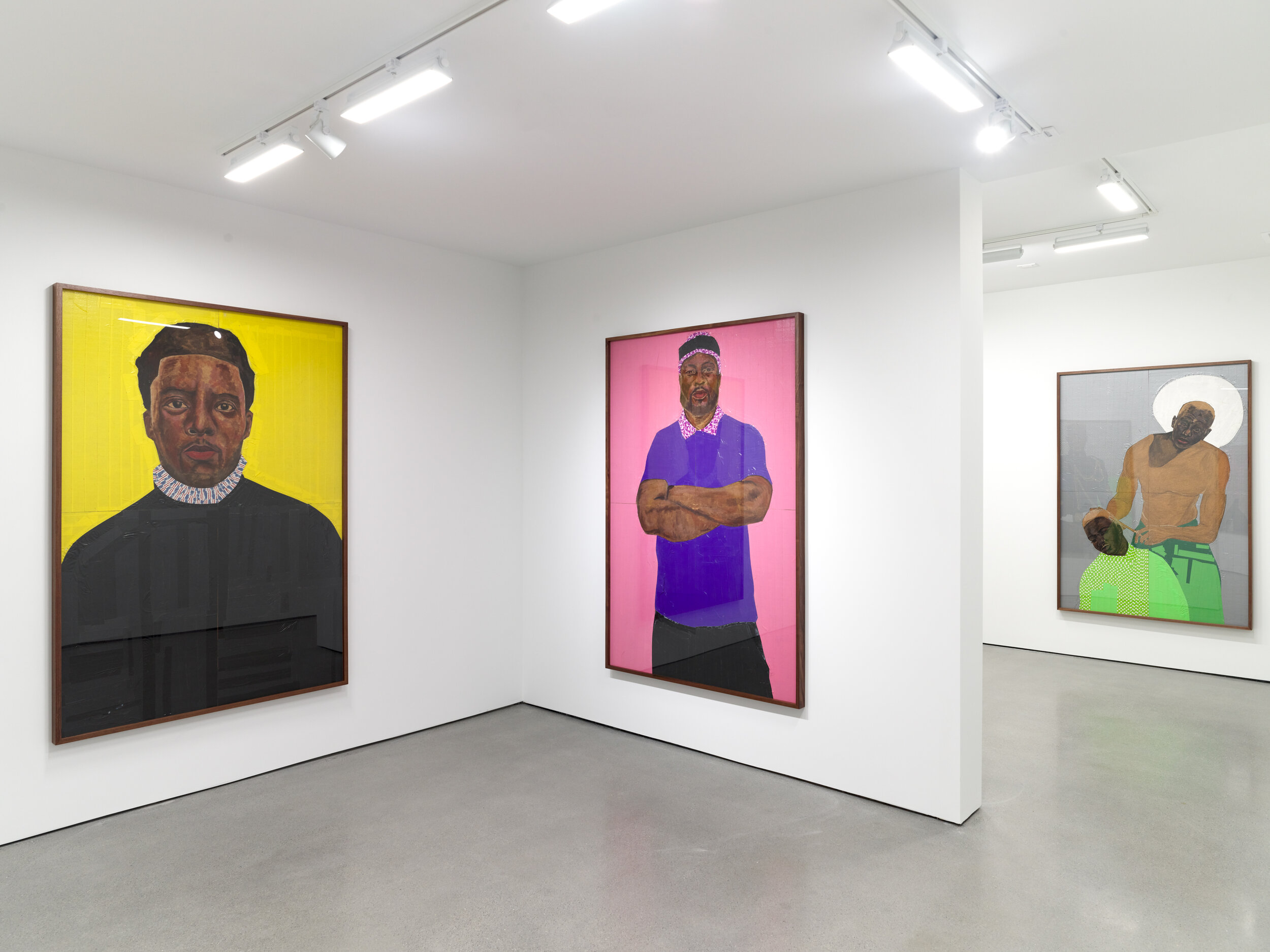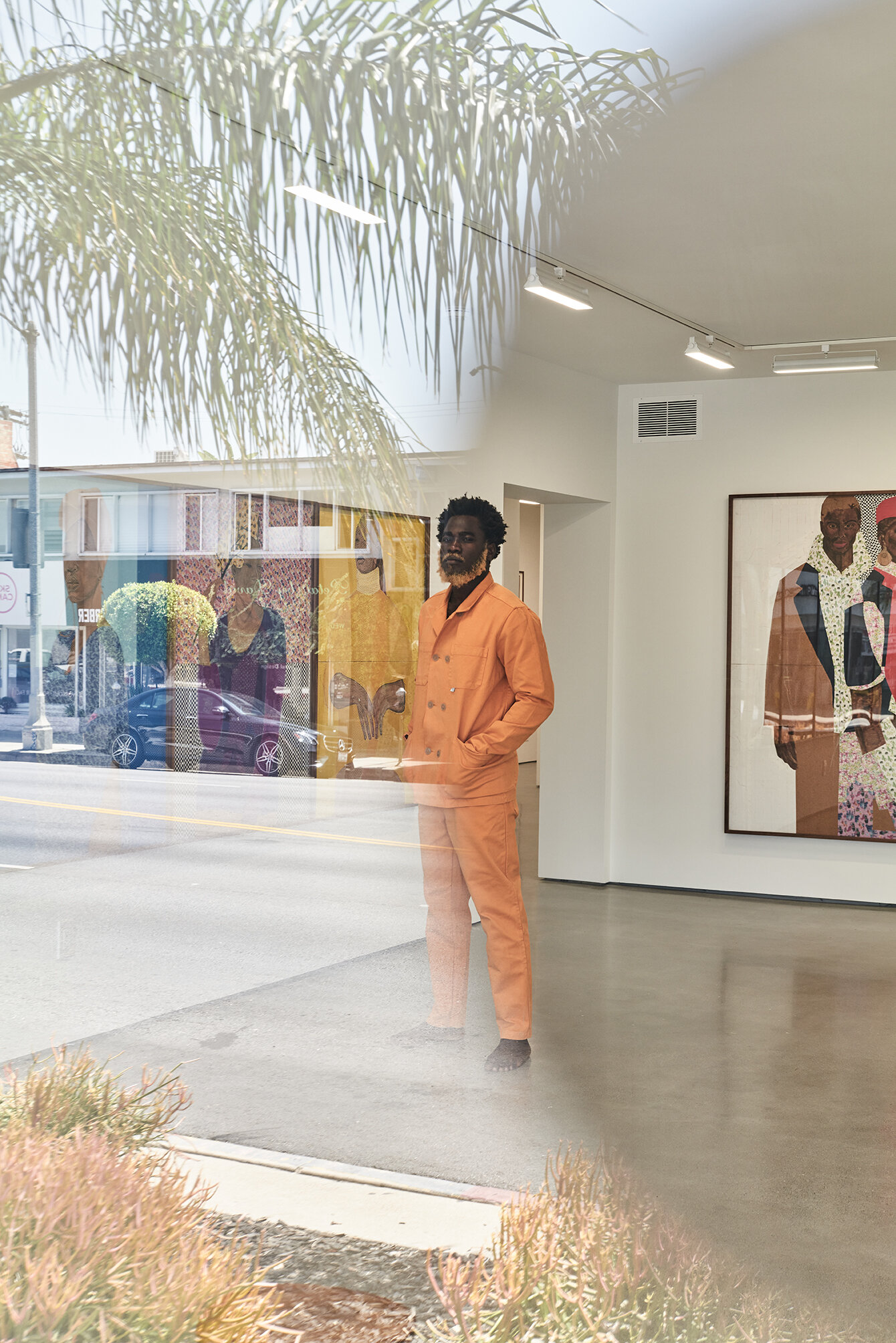
SERGE ATTUKWEI CLOTTEY
Amanda Quinn Olivar speaks with the acclaimed artist about his community-focused artistic practice and Beyond Skin, his recent exhibition at Simchowitz Gallery in Los Angeles.
Serge Attukwei Clottey is an Accra-based artist who works in various mediums to explore migration, identity, and the environment. He studied at the Ghanatta College of Art and Design in Ghana and the Escola Guindard University of Art in Brazil. In 2019, Clottey received an Honorary Doctorate of Art from the University of Brighton. He has had solo exhibitions at Lorenzelli Arte in Milan, Ever Gold Projects in San Francisco, The Mistake Room in Los Angeles, Gallery 1957 in Accra, Jane Lombard Gallery in New York, and Feuer/Mesler in New York, among others.
More recently, Clottey showed his abstract and expansive sculptural installation made out of flattened, yellow Kuffuor gallon containers at the Desert X biennial exhibition in Palm Springs. In his latest solo exhibition at Simchowitz Gallery, Beyond Skin, Clottey presented a collection of paintings and drawings of various figures, ranging from the late actor Chadwick Boseman to figures from his Instagram feed, clad in vibrant, unique clothes that force viewers to confront their individuality and gender expression.
Interview by Amanda Quinn Olivar
To begin with, why do you make art?
Everyone who knows me from infancy will say it was obvious that I'd become an artist. That's because my Dad, Seth Clottey, is an artist... and so even before I went to art school, I had started painting by learning from my dad. However, after art school, I realized that I could use art to provoke conversations about issues that affect my community, country, and the world at large. The intention to use art to get people to talk and share ideas about issues concerning my people in my immediate environment, and relatable to people outside of my community, is one of the many reasons I make art.
Can you tell us about your upbringing in Ghana and how it shaped the direction of your work?
My upbringing in Ghana, I will say, was communal. By this, I mean I grew up in a community where we all lived as one big family in my area. I was brought up in an extended family setting where every adult was responsible for every child in the community, regardless of the house they come from.
In relation to my work, it is easy for people to identify the significance of 'community' in it. From the sourcing of materials to the production process, it is more like a communal work than an individual's work. Even if you look at the politics of trade, environment, and histories I explore in my work, you notice that it starts with my family and the community I was raised in.
Portrait of Serge Attukwei Clottey at his exhibition, Beyond Skin, Simchowitz Gallery, Los Angeles, April 17—May 8, 2021. Courtesy of Simchowitz Gallery
Let’s talk about your subject matter and your focus...
We don't create art in a void… For me, I believe every artist, and just like musicians and film producers, create works based on specific narratives they've explored or are investigating. They present their findings in unique ways that either educate, inform, entertain or start a conversation. That's where we start looking at the subject matter... So I believe in every artistic dispensation, your subject matter is the starting point in creating a shared understanding.
So for me, my subject matter has always been about issues that affect my country, be it partisan politics, media, environment (illegal mining and plastic pollution), history, and[/or] trade. It’s easy to see these themes in my performances, photography, paintings, and sculptures. So from what I’ve said, I guess you know where my focus is...
Chadwick, 2020-2021, oil paint, duct tape on cork board 71 x 46.5 inches
Fashion icons, 2020-2021, oil paint, duct tape on cork board, 71 x 47.5 inches
Are there common themes that carry across your different series?
Yes, there are common themes that cut across the various mediums I use in creating. For example, you can easily see themes about the environment and materiality in most of my series. Also, my family history, and media, especially new media (social media)...
Can you tell us about Afrogallonism, what drove you to create it, and what you hope to communicate? Are there specific reactions you hope to stir up or conjure in your audiences?
Afrogallonism, in much more simple terms, is an artistic intervention where I'm looking at ways we deal with plastic (mostly the Jerry cans) in our community. I explore the origins of these plastic materials, their use, and what becomes of them when they have outlived their purpose in peoples' homes. Also, what can I, as an artist, create out of these discarded materials... This project aims to provoke serious conversation around the consumption of these materials and the issue of water scarcity in Ghana, Africa, and the world.
An installation of Serge Attkwei Clottey’s work using repurposed materials which he refers to as “Afrogallonism.” Image courtesy of Simchowitz Gallery
Serge Attukwei Clottey | Desert X 2021 Performance
You're known for experimenting with discarded, everyday things. What are some of the most unconventional materials you've worked with? When deciding on materials, what are the most important factors you consider? Are there any materials you’d like to explore next that you haven’t tried yet?
I honestly can’t point out any unconventional material I've used. I think most of the materials I used are discarded materials I source from people’s homes and dump sites, meaning these materials are being used for the day-to-day activities of people in the community. So I don’t regard them as unconventional. Instead, I'd rather say I sometimes create unconventional artworks out of these discarded materials.
When it comes to materials, it just has to fit in the idea I'm exploring. Before I use a material, I ask myself… what is the significance of the material to the idea I’m developing or the work I’m creating? Artists are always working with new materials, but artists don’t go for any material because they think it will be aesthetically pleasing to others, but rather the importance of the material to the work they are creating.
Tapestries from Serge Clottey’s Afrogallonism series being assembled. Photo by Nil Odzenma. Courtesy of Simchowitz Gallery
Installation view of Serge Attukwei’s work. Image courtesy of Simchowitz Gallery
The title of your first solo exhibition in Los Angeles at Simchowitz Gallery is Beyond Skin. Please tell us about that title, the work on view... and the cast of characters you portray.
I believe you know figurative paintings of black bodies are in vogue now. And it will be easy to classify my new works under this trend. But that is not what I’m interested in. For my new works, I want people to look past the color of the people in the paintings and rather focus on the many themes I explore in them. One can look at themes like materiality, fashion, and media in these works.
As an ardent user of social media, I look at how this form of media influences Africans who are social media savvy... from their fashion sense, [to] language, and how they choose to present themselves to the world via social media. That is the reason why I chose most characters from social media. The characters in these paintings are friends, artists, fashionistas, and random black people worldwide.
Installation view, Beyond Skin, Simchowitz Gallery, Los Angeles, April 17—May 8, 2021. Courtesy of Simchowitz Gallery.
Was there any more specific moment or impetus that inspired this series?
I was inspired by how young Africans are using social media to tell stories about themselves, their communities, and their continent. In Okwui Enwezor’s book Snap Judgments: New Positions in Contemporary African Photography, he spoke about how the discovery of works by African photographers like Seydou Keita contributed to the rewriting of African history from the angle of 'Afro-pessimism' to a more respectable angle. I believe this has not changed, and young Africans are continuing the works of Seydou Keita, Malick SidIbé, James Barnor, and many others through social media channels like Instagram. I can say this, among many others, inspires these new works.
Installation view, Beyond Skin, Simchowitz Gallery, Los Angeles, April 17—May 8, 2021. Courtesy of Simchowitz Gallery.
Serge Attukwei Clottey studio image, courtesy of Simchowitz Gallery
Serge Attukwei Clottey studio image, courtesy of Simchowitz Gallery
Is your process generally spontaneous or more planned?
My work process is planned. From the selection of an image on social media to the type of duct tape I use is usually planned.
Is there a story behind Asantewaa?
I can’t say there’s a specific story behind Asantewaa. She’s a Ghanaian spoken word artist I’ve collaborated with before on a project some years back. She's a strong feminist who's creating works and developing interventions that are helping her fellow female artists and emerging female creatives in Accra hone their talents. Some years back, she, together with some friends, founded 'Black Girls Glow.'
Asantewaa, 2020-2021, oil paint, duct tape on cork board, 71 x 47.5 inches
What is your favorite art accident? Did it change your perspective?
I won’t call it an accident... I’d rather an art opportunity. This was when a benevolent Brazilian I met on Facebook decided to fund my art education in Brazil. It did change my perspective, and the product of that change in perspective is what has made me today and the work I make now.

Portrait of Serge Attukwei Clottey at his exhibition, Beyond Skin, Simchowitz Gallery, Los Angeles, April 17—May 8, 2021. Courtesy of Simchowitz Gallery










